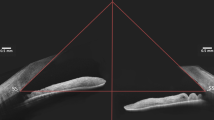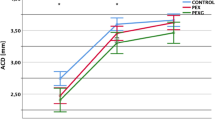Abstract
Objective
To investigate dynamic iris changes in patients with primary angle-closure disease (PACD) with long axial length (AL) compared to those with short and medium AL.
Methods
This observational cross-sectional study enrolled participants aged 35 years or older from the Handan Eye Study follow-up examination who were diagnosed with PACD and underwent Visante anterior segment optical coherence tomography (ASOCT) imaging under light and dark conditions. The right eye of each participant was included in the analysis. AL was categorized as short (<22.0 mm), medium (≥22.0 to ≤23.5 mm), or long (>23.5 mm). Anterior segment parameters, including iris dynamic changes, were compared among the three groups with different ALs.
Results
Data from 448 patients with PACD were analyzed. We found that 10.9% of included eyes had a long AL with a flatter cornea; larger central anterior chamber depth, angle opening distance, anterior chamber width, anterior chamber area, and volume; and smaller lens thickness and lens vault (LV) (P < 0.05) than those with short AL. No significant difference existed between the three groups in iris thickness, iris cross-sectional area (IA), iris curvature, or pupil diameter (PD) change between light and dark (P > 0.05). The significant associated factors for IA changes were area recess area (ARA) in the dark, LV in the dark, and PD change from light to dark (P < 0.05).
Conclusions
Dynamic and static iris parameters were consistent across patients with PACD with short, medium, or long AL and may contribute to the pathogenesis of angle closure in atypical PACD.
This is a preview of subscription content, access via your institution
Access options
Subscribe to this journal
Receive 18 print issues and online access
$259.00 per year
only $14.39 per issue
Buy this article
- Purchase on Springer Link
- Instant access to full article PDF
Prices may be subject to local taxes which are calculated during checkout

Similar content being viewed by others
References
Foster PJ, Buhrmann R, Quigley HA, Johnson GJ. The definition and classification of glaucoma in prevalence surveys. Br J Ophthalmol. 2002;86:238–42.
Tham YC, Li X, Wong TY, Quigley HA, Aung T, Cheng CY. Global prevalence of glaucoma and projections of glaucoma burden through 2040: a systemic review and meta-analysis. Ophthalmology. 2014;121:2081–90.
Foster PJ, Johnson GJ. Glaucoma in China: how big is the problem? Br J Ophthalmol. 2001;85:1277–82.
Marchini G, Pagliarusco A, Toscano A, Tosi R, Brunelli C, Bonomi L. Ultrasound biomicroscopic and conventional ultrasonographic study of ocular dimensions in primary angle-closure glaucoma. Ophthalmology. 1998;105:2091–8.
Lowe RF. Aetiology of the anatomical basis for primary angle-closure glaucoma. Biometrical comparisons between normal eyes and eyes with primary angle-closure glaucoma. Br J Ophthalmol. 1970;54:161–9.
Yong KL, Gong T, Nongpiur ME, How AC, Lee HK, Cheng L. et al. Myopia in Asian subjects with primary angle closure: implications for glaucoma trends in East Asia. Ophthalmology. 2014;121:1566–71.
Li M, Kong X, Zhu W, Chen Y, Chen J, Sun X. Changes of anterior segment parameters in primary angle closure with axial myopia: a retrospective study of 369 patients grouped by axial length. Acta Ophthalmol. 2016;94:e670–1.
Li M, Chen Y, Jiang Z, Chen X, Chen J, Sun X. What are the characteristics of primary angle closure with longer axial length? Invest Ophthalmol Vis Sci. 2018;59:1354–9.
Zhang Y, Zhang Q, Li SZ, He MG, Li SN, Wang NL. Anterior segment characteristics and risk factors for primary angle closure disease with long axial lengths: The Handan Eye Study. Invest Ophthalmol Vis Sci. 2023;64:8.
Barkana Y, Shihadeh W, Oliveira C, Tello C, Liebmann JM, Ritch R. Angle closure in highly myopic eyes. Ophthalmology. 2006;113:247–54.
Su CW, Chen HY. Acute angle closure in the setting of high axial myopia: a case report. Am J Ophthalmol Case Rep. 2016;1:31–3.
Chakravarti T, Spaeth GL. The prevalence of myopia in eyes with angle closure. J Glaucoma. 2007;16:642–3.
Loh CC, Kamaruddin H, Bastion MC, Husain R, Mohd Isa H, Md Din N. Evaluation of refractive status and ocular biometric parameters in primary angle closure disease. Ophthalmic Res. 2021;64:246–52.
Liang Y, Shen R, Zhou W, Fan S, Chan PP, Tham CCY. et al. Prevalence and ocular biometric characteristics of myopia in primary angle closure disease in rural China: The Handan Eye Study. Invest Ophthalmol Vis Sci. 2022;63:19
Thomas R, Walland MJ. Primary angle-closure glaucoma is a multifactorial disease. Clin Exp Ophthalmol. 2011;39:593–4.
Wang B, Sakata LM, Friedman DS, Chan YH, He M, Lavanya R. et al. Quantitative iris parameters and association with narrow angles. Ophthalmology. 2010;117:11–7.
Quigley HA, Silver DM, Friedman DS, He M, Plyler RJ, Eberhart CG. et al. Iris cross-sectional area decreases with pupil dilation and its dynamic behavior is a risk factor in angle closure. J Glaucoma. 2009;18:173–9.
Wang BS, Narayanaswamy A, Amerasinghe N, Zheng C, He M, Chan Y-H. et al. Increased iris thickness and association with primary angle closure glaucoma. Br J Ophthalmol. 2011;95:46–50.
Zhang Y, Li SZ, Li L, He MG, Thomas R, Wang NL. Quantitative analysis of iris changes after physiologic and pharmacologic mydriasis in a rural Chinese population. Invest Ophthalmol Vis Sci. 2014;55:4405–12.
Zhang Y, Li SZ, Li L, He MG, Thomas R, Wang NL. Quantitative analysis of iris changes following mydriasis in subjects with different mechanisms of angle closure. Invest Ophthalmol Vis Sci. 2015;56:563–70.
Seager FE, Jefferys JL, Quigley HA. Comparison of dynamic changes in anterior ocular structures examined with anterior segment optical coherence tomography in a cohort of various origins. Invest Ophthalmol Vis Sci. 2014;55:1672–83.
Liang YB, Friedman DS, Wong TY, Wang FH, Duan XR, Yang XH. et al. Rationale, design, methodology, and baseline data of a population-based study in rural China: the Handan Eye Study. Ophthalmic Epidemiol. 2009;16:115–27.
Cao K, Hao J, Zhang Y, Hu A-L, Yang X-H, Li S-Z. et al. Design, methodology, and preliminary results of the follow-up of a population-based cohort study in rural area of northern China: Handan Eye Study. Chin Med J (Engl). 2019;132:2157–67.
Console JW, Sakata LM, Aung T, Friedman DS, He M. Quantitative analysis of anterior segment optical coherence tomography images: the Zhongshan Angle Assessment Program. Br J Ophthalmol. 2008;92:1612–6.
Nongpiur ME, He M, Amerasinghe N, Friedman DS, Tay WT, Baskaran M. et al. Lens vault, thickness, and position in Chinese subjects with angle closure. Ophthalmology. 2011;118:474–9.
Moghimi S, Vahedian Z, Zandvakil N, Mohammdi M, Fakhraie G, Nassiri N. et al. Role of lens vault in subtypes of angle closure in Iranian subjects. Eye (Lond). 2014;28:337–43.
Tarongoy P, Ho CL, Walton DS. Angle-closure glaucoma: the role of the lens in the pathogenesis, prevention, and treatment. Surv Ophthalmol. 2009;54:211–25.
Park SH, Park KH, Kim JM, Choi CY. Relation between axial length and ocular parameters. Ophthalmologica. 2010;224:188–93.
Atalay E, Nongpiur ME, Baskaran M, Sharma S, Perera SA, Aung T. Biometric factors associated with acute primary angle closure: comparison of the affected and fellow eye. Invest Ophthalmol Vis Sci. 2016;57:5320–5.
Zhang Y, Li SZ, Li L, He MG, Thomas R, Wang NL. Dynamic iris changes as a risk factor in primary angle closure disease. Invest Ophthalmol Vis Sci. 2016;57:218–26.
He M, Lu Y, Liu X, Ye T, Foster PJ. Histologic changes of the iris in the development of angle closure in Chinese eyes. J Glaucoma. 2008;17:386–92.
Gazzard G, Friedman DS, Devereux JG, Chew P, Seah SK. A prospective ultrasound biomicroscopy evaluation of changes in anterior segment morphology after laser iridotomy in Asian eyes. Ophthalmology. 2003;110:630–8.
Funding
This study was supported by the Dongcheng District Outstanding Talent Nurturing Program (Grant Number 2022-dchrcpyzz-63), the Research Special Fund of the Ministry of Health of the People’s Republic of China (Grant Number 201002019), and the Beijing Hospitals Authority Youth Program (Grant Number QML20210201). The funding organization had no role in the design or conduct of the study.
Author information
Authors and Affiliations
Contributions
NW and Ye Zhang contributed to the design, acquisition of funding, and general supervision of the research group. JW and YW contributed to the design, results analysis, and manuscript drafting. QZ and SZL contributed to the data collection. MGH contributed to the manuscript revision. All authors reviewed and edited the manuscript and approved the final version of the manuscript.
Corresponding authors
Ethics declarations
Competing interests
The authors declare no competing interests.
Additional information
Publisher’s note Springer Nature remains neutral with regard to jurisdictional claims in published maps and institutional affiliations.
Supplementary information
Rights and permissions
Springer Nature or its licensor (e.g. a society or other partner) holds exclusive rights to this article under a publishing agreement with the author(s) or other rightsholder(s); author self-archiving of the accepted manuscript version of this article is solely governed by the terms of such publishing agreement and applicable law.
About this article
Cite this article
Wang, J., Wang, Y., Zhang, Q. et al. Quantitative analysis of dynamic iris changes in primary angle-closure disease with long axial lengths: the Handan Eye Study. Eye (2024). https://doi.org/10.1038/s41433-023-02905-1
Received:
Revised:
Accepted:
Published:
DOI: https://doi.org/10.1038/s41433-023-02905-1



